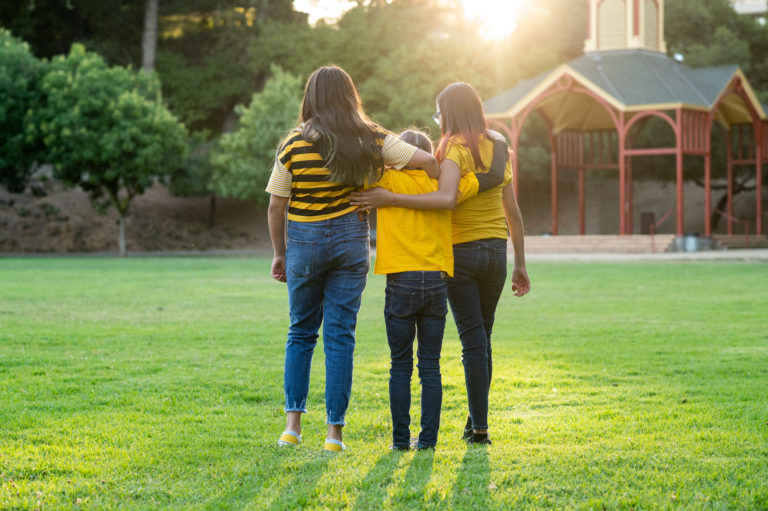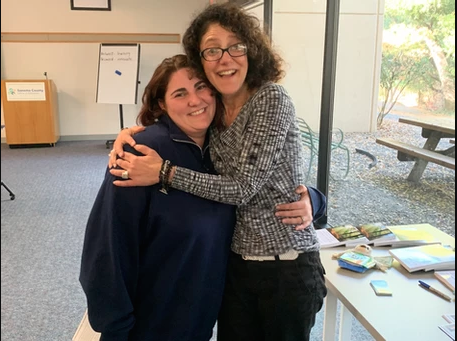All Work and No Play: Bringing Joy Back Into Your Family
By Carey A. Gil, LCSW
As a therapist and TBRI Practitioner working with people who have experienced many different types of trauma, I often give the same surprising advice—have more fun!
This is often met with skepticism, confusion or outright resistance. Managing the thoughts, emotions and behaviors that accompany trauma and stress usually leaves us depleted and without the energy we think we need to find joy and fun again. The very thought may feel overwhelming and out of reach.
The reality couldn’t be any further from the truth! Ironically, when we de-prioritize fun and play in our families we are depriving ourselves of the very thing that can speed up our healing process and create what we crave most—a connected family life.
Biological Benefits of Play
When we play, our brains “light up” like a veritable Las Vegas skyline. Deceptively simple, play stimulates many different areas of our brain, forms new connections, and boosts key neurochemicals we need to feel motivated, connected to others, and to learn. Levels of dopamine (“Feel good” neurotransmitter), serotonin (“self love”) and oxytocin (“bonding”) in our body dictate how much attention and focus are available to us as well as our ability to regulate emotional, cognitive and physical responses at any given moment. Playful activities flood our brains with helpful chemicals to reduce stress and improve our moods. Play can create new muscle memory used to learn and practice new skills. It stimulates the powerful tool of imagination which can help manage stress and build mental schemas for future possibilities.
The impulse for curiosity and fun is our natural state as children. However, when we experience trauma, this instinct often is inhibited and overridden by the ways we cope with that trauma – such as isolation, denial, and the development of self-protective defense mechanisms. An easily sparked “fight or flight” response can get in the way of both our desire to engage in play and our success at it. Play is the key to disarming the fear response, creating relational safety and a physiological state of relaxation.
If play is the safest, healthiest, and most effective way to improve our emotional wellbeing, learn new skills, overcome challenges and increase interpersonal connectedness, why do we often leave this last on our parental “to do” list?
Play is not just for kids
The work of parenting and managing daily life has left us de-prioritizing fun and connection, often relegating them to the “kids zone”. However, for our physical and emotional wellbeing, play is not a luxury – it is essential. As the leaders of our families, parents have a responsibility to model the value of play, to create fun and relaxing atmospheres where playfulness can thrive, and to proactively seek playful connections. Small, meaningful moments during the course of a day add up to measurable changes in the moods and relationships within the family. Infuse lightness and playfulness into your daily interactions with your children mindfully and wherever possible. If you’re an adult who didn’t get enough play in your childhood, this is your opportunity to reparent yourself.
Ways to Bring Joy Back to Your Family:
MODEL HEALTHY HABITS: Kids imitate what they see so parents need to model lightness and play in their interactions with each other and through daily life. Validate the need for fun, show curiosity about what the kids like, join a recreational inner tube water polo team – whatever floats your boat!
MAKE IT EASY: Find small, meaningful moments for play which fit your family’s lifestyle, values and personalities. Most kids with trauma have sensory needs which make concentration, sitting still, and even losing at games a challenge, so big “events” can be overwhelming and sometimes lead to meltdowns. Think about small games and moments of fun which can be accomplished in a short time, with items you have on hand around the house or in the car. Don’t wait for a trip to Disneyland – dance around the house to a song while doing dishes, or have a marshmallow eating contest* after dinner! (*Safety risk, so assess appropriateness for the child and age in your home.)
CREATE PLAY ROUTINES: Be structured about the amount of screen time your kids (and adults!) enjoy in order to make space for the other types of fun. Have scheduled spaces in your daily routine for other types of fun including family play time together. Schedule regular time together to reconnect in a fun way, weekly and daily. Have a round of Uno after dinner. Watch a funny movie on Friday nights. Have a karaoke contest in the car on the way home from school.
PROVIDE MATERIALS AND “FUN COACHING”: Consider “I’m bored” as an opportunity for creative exploration! Be prepared to offer suggestions and handholding – if your children (or you!) have been deprived of play, they may not know where to start. Post a visible list of ideas. Store games and art supplies where they are easily accessible and in view. Have a mix of self-lead (e.g. Play-doh, Legos) and multi-player games (e.g. board games). Play with and alongside your child until they develop enough “reward” chemical to self-motivate.
LAUGH! Ask yourself—have I laughed with my kid today? If not, go make it happen. Even the act of smiling helps!
“STACKING”— DAILY LIFE + FUN: Add something pleasurable on top of regular mundane activities. Sing while doing dishes, dance while brushing teeth, march down the hall to the shower. Use a funny voice or exotic accent to read directions or help with homework.
TEACHING SKILLS: Engage in games which foster attunement, bonding and building skills like taking turns, cooperation and compliance. Classic playground favorites like “Mother May I”, “Red Light/Green Light”, “Hide and Seek” and “Simon Says” are great for this!
INCORPORATE ALL OF THE SENSES: Incorporate tactile games (Twister, Jenga), art projects (PlayDoh, baking, shaving cream) and active play (wrestling, wrapping up like a burrito.) Activities that require balancing, swinging, jumping and dancing also do the trick!
5 MINUTES OF CONNECTED FUN (CHILD LEAD): Spend at least 5 minutes daily with each child doing an activity of their choice. Watch their favorite TikTok. Create with Legos following their lead. Resist the urge to “manage” their play by asking questions, critiquing or guiding them to create something specific. Let them lead, follow along, and let the games begin!
Carey Gil, LCSW has spent over 20 years supporting Bay Area families in their growth and healing. She firmly believes in the human power to triumph and blossom after hardship and trauma because she has borne witness to it hundreds of times. She holds advanced certificates and training in trauma and therapy modalities including: TBRI Practitioner, Certified Family Trauma Professional, Trauma-Focused Cognitive Behavioral Therapy, Dialectical Behavioral Therapy, Emotional Freedom Technique and the Trauma Research Foundation’s Certificate in Traumatic Stress Studies, where she studied under Bessel van der Kolk.
With training and experience working extensively with foster youth, foster/adoptive families, divorce/coparenting and families in crisis, she is a wise and encouraging voice to guide you on your journey. She loves supporting families to bond, repair relationships and grow, and to support individuals in their personal trauma healing. She has developed trainings and coached biological, foster and adoptive families through family court, DFCS, and the Refugee Foster Care program. Her direct work with individual and family trauma recovery has given her a unique lens on how to marry traditional parenting and therapy methods with trauma-informed interventions that actually create stronger relationships and mental health healing.
Carey is a private practice therapist at Lotus Counseling Services in San Jose (https://lotuscounselingca.com). She is also a Lecturer and Faculty Field Liaison at the SJSU Graduate School of Social Work where enjoys sharing her passion with the next generation of helping professionals. Beyond her professional responsibilities, Carey says that her greatest learning is done at home parenting her own children, who have a variety of special emotional and educational needs.









